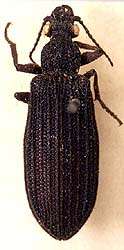Ommatidae
The Ommatidae are a family of beetles in the suborder Archostemata.[1] The Ommatidae are considered the extant beetle family that has most ancestral characteristics.[2] Extant species of this group only occur in Australia and South America, but the geographical distribution was much wider during the Mesozoic spanning across modern day Europe, Siberia, Myanmar, and China. Discovery of Upper Jurassic Chinese and Upper Cretaceous Burmese amber fossils suggest that they were widespread on Pangea.[3] So far, 13 extinct genera containing over 100 species of these beetles have been described.[4] Three extant genera have been assigned to this family: Omma, Tetraphalerus and Beutelius.[5] The family is considered to be a subfamily of Cupedidae by some authors.
| Ommatidae | |
|---|---|
 | |
| Omma stanleyi | |
| Scientific classification | |
| Kingdom: | Animalia |
| Phylum: | Arthropoda |
| Class: | Insecta |
| Order: | Coleoptera |
| Suborder: | Archostemata |
| Family: | Ommatidae Sharp & Muir, 1912 |
Genera
Extinct genera
- †Blapsium Westwood, 1854
- †Brochocoleus Hong, 1982
- †Cionocoleus Ren, 1995
- †Eurydictyon Ponomarenko, 1969
- †Fuscicupes Hong & Wang, 1990
- †Lithocupes Ponomarenko, 1966
- †Notocupoides Ponomarenko, 1966
- †Rhabdocupes Ponomarenko, 1966
- †Zygadenia Handlirsch, 1906
Extant genera
- Omma Newman, 1839
- Tetraphalerus Waterhouse, 1901
- Beutelius Escalona et al, 2020
References
- "Australian Faunal Directory". Department of the Environment and Energy. Archived from the original on 2011-03-11. Retrieved 2009-11-21.
- Hünefeld, Frank; Marvaldi, Adriana E.; Müller, Bianca; Lawrence, John F.; Beutel, Rolf Georg (2011). "The male postabdomen of the "ancestral" archostematan beetle Tetraphalerus bruchi Heller, 1913 (Ommatidae) and its phylogenetic significance". Arthropod Structure & Development. 40 (2): 146–158. doi:10.1016/j.asd.2010.12.003. PMID 21185393.
- Yamamoto, Shûhei (2017). "A new genus of Brochocoleini beetle in Upper Cretaceous Burmese amber (Coleoptera: Archostemata: Ommatidae)". Cretaceous Research. 76: 34–39. doi:10.1016/j.cretres.2017.04.008.
- Tan, Jingjing; Wang, Yongjie; Ren, Dong; Yang, Xingke (2012). "New fossil species of ommatids (Coleoptera: Archostemata) from the Middle Mesozoic of China illuminating the phylogeny of Ommatidae". BMC Evolutionary Biology. 12: 113. doi:10.1186/1471-2148-12-113. PMC 3518168. PMID 22776212.
- "Ommatidae Species List". Joel Hallan’s Biology Catalog. Texas A&M University. Archived from the original on 2012-10-23.
External links

- Ommatidae Tree of Life
- "Ommatida". Atlas of Living Australia.